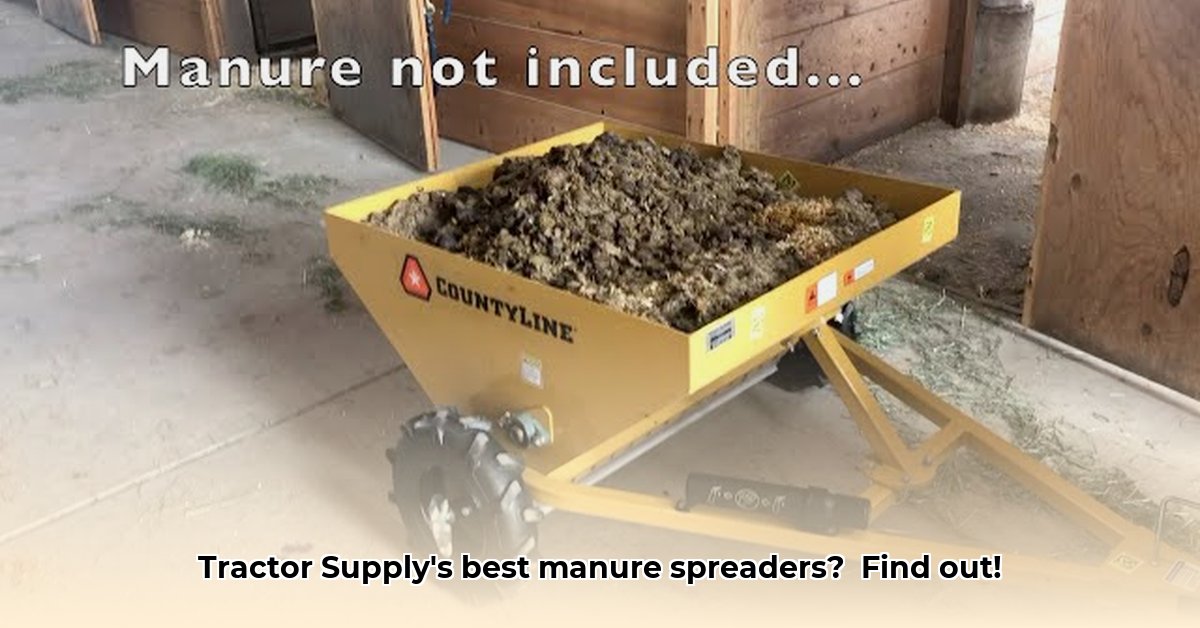
Manure Spreader Selection: Optimizing Efficiency and Sustainability
Choosing the right manure spreader significantly impacts farm efficiency and environmental sustainability. This guide helps you navigate the options available at Tractor Supply, focusing on factors crucial for informed decision-making. We'll examine spreader types, capacity considerations, and application methods, ultimately guiding you towards a choice that aligns with your farm's specific needs. For more information on pull-behind spreaders, check out this helpful resource: Tractor Supply Spreaders.
Assessing Your Farm's Requirements: Scale and Application
The first step involves accurately assessing your farm's size and manure production volume. A small farm with limited livestock will have drastically different requirements than a large operation. This directly influences the necessary spreader capacity and features.
"Ignoring your farm's scale when choosing a manure spreader is like trying to paint a house with a toothbrush," advises Dr. Emily Carter, Agricultural Engineer at Purdue University. "The right tool significantly improves efficiency and reduces wasted time and effort."
Consider the following:
- Farm size (acres): This dictates the area needing coverage and the total manure volume.
- Livestock numbers and type: Different animals produce varying manure volumes and compositions.
- Manure storage and handling: Existing infrastructure affects the spreader's required capacity and features.
A small, lightweight spreader, such as the Loyal 23-bushel model, might suffice for smaller farms or specific tasks requiring precision. Larger operations, however, will require a more robust model, possibly a 3-point hitch spreader like the Field Tuff FTF-200S3PT. These larger units offer greater capacity and efficiency for handling substantial manure volumes.
Spreader Types: PTO vs. Ground-Driven
The primary spreader types available are PTO (Power Take-Off) and ground-driven. Each boasts unique advantages and disadvantages, crucial for aligning the spreader with operational requirements.
PTO-Driven Spreaders: These spreaders are driven by the tractor's PTO, offering higher capacity and more even spreading patterns. Advanced models often incorporate GPS guidance for precise application. However, they require a tractor with a PTO and typically demand a larger investment.
Ground-Driven Spreaders: Operated independently, these units are often less expensive and easier to maintain. They are suitable for smaller farms with lower manure volumes, but offer lower capacity and may have less precise spreading than PTO models. The choice depends on operational scale and budget considerations.
Quantifiable Fact: PTO-driven spreaders typically have a 20-50% greater capacity than comparable ground-driven models.
Application Methods and Precision Agriculture
Even spreading is paramount for optimal nutrient utilization and environmental protection. Uneven application leads to nutrient imbalances, negatively impacting crop yields and potentially polluting water sources.
"Precision application is no longer a luxury; it's a necessity for sustainable manure management," states Mark Olsen, Soil Scientist at the University of Illinois. "Modern spreaders with GPS guidance can dramatically improve efficiency and minimize environmental risks."
This necessitates considering the spreader's spreading pattern and width. While detailed specifications aren't always readily available, it is crucial to inquire about this directly from Tractor Supply or the manufacturers. Features like variable-rate technology offer enhanced application control, adapting to soil conditions and nutrient needs.
Cost Considerations: Total Cost of Ownership
The initial purchase price is just one aspect of the overall cost. Factor in fuel consumption (for motorized spreaders), maintenance expenses, and potential repair costs over the spreader's lifespan. It's not simply about the upfront investment but the total cost of ownership over several years.
Rhetorical Question: Is a slightly higher initial investment justified by significant long-term cost savings due to increased efficiency and reduced downtime?
A larger, more efficient spreader may initially cost more, but it could save time and money in the long run by reducing the number of trips required to spread the same amount of manure. Thoroughly analyze both the upfront and long-term costs before making a decision.
Choosing Your Spreader: A Practical Guide
- Assess your farm's needs: Determine manure volume, farm size, and handling infrastructure.
- Choose a spreader type: Select PTO or ground-driven based on capacity needs and tractor availability.
- Prioritize spreading pattern and width: Inquire about these features to guarantee even distribution.
- Consider additional features: Explore GPS guidance or variable-rate technology for enhanced precision.
- Analyze long-term costs: Estimate the total cost of ownership (fuel, maintenance, repairs) over 5-10 years.
- Consult local experts: Seek advice from agricultural extension agents and experienced farmers.
This structured approach will help you find the right manure spreader suitable for your operation, ensuring optimal efficiency and sustainability. Remember, the right choice significantly impacts your farm's long-term success.